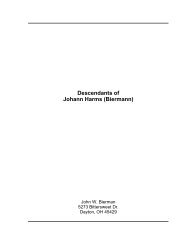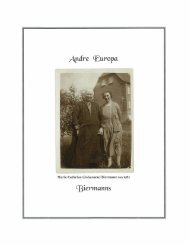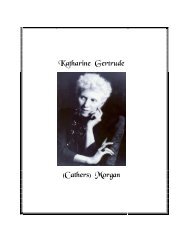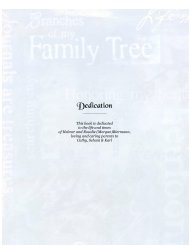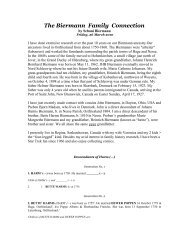A Collection of Dad's Essay's & Writings - Welcome
A Collection of Dad's Essay's & Writings - Welcome
A Collection of Dad's Essay's & Writings - Welcome
You also want an ePaper? Increase the reach of your titles
YUMPU automatically turns print PDFs into web optimized ePapers that Google loves.
During the War Years from 1939 until 1945 the Saint John port was a beehive <strong>of</strong> activity and many ships with<br />
Danish, Swedish, Norwegian and Finnish crew members came to the church and <strong>of</strong>ten attended the church services<br />
and during the Christmas season, there were parties in the church hall. One memorable event was at Christmas 1944<br />
when upwards <strong>of</strong> 150 persons packed into the building on Second Street. Danish and Norwegian sailors were at sea on<br />
Allied ships, including the famous Empire Knight which was torpedoed <strong>of</strong>f the coast <strong>of</strong> New England and made the<br />
news in the 1990’s when it was discovered that dangerous material was stored in the hull <strong>of</strong> the wreck. The Swedish<br />
sailors were crew members <strong>of</strong> the vessels in the white fleet that sailed from Saint John to Piraeus, Greece with grain<br />
for the Greek population. Many <strong>of</strong> the guests at church services and congregational parties came from Swedish vessels<br />
such as the MV Formosa and MV Nagara, which were in the port for seven to ten days. T. P. Larsen, who was the<br />
Honorary Danish Vice-Counsel in Saint John, assisted in directing Scandinavian seamen to the church.<br />
The “Young Peoples”, as it was designated until the phrase “Luther League” was coined in another part <strong>of</strong> the<br />
country, became an integral part <strong>of</strong> the church with meetings each Thursday evening. The young people, with the<br />
pastor as adviser, <strong>of</strong>fered prayers, messages, bible readings, hymn singing and various forms <strong>of</strong> entertainment. The<br />
organization had a president, vice-president, secretary and treasurer and every member was given an opportunity to<br />
contribute to the evening’s meeting. There were always refreshments with c<strong>of</strong>fee, tea or a carbonated drink. For a<br />
number <strong>of</strong> years during the mid-1940’s, Hudson Spear, a former theater pianist in his hometown <strong>of</strong> Sussex, was the<br />
<strong>of</strong>ficial accompanist, who quickly learned to play the Danish hymns and the Danish folksongs. For a couple <strong>of</strong> years<br />
this Presbyterian was more or less adopted as an honorary Lutheran and could be depended on to accompany the<br />
hymns and songs at these Thursday gatherings (without remuneration-he was one <strong>of</strong> the gang). The marks <strong>of</strong> his<br />
lighted cigarettes were forever engraved on the ivory keys <strong>of</strong> the piano as he accompanied the singing.<br />
Many Thursday evenings were given over to congregational events in which both the adult members and the<br />
young people collaborated. One such occasion was after the Nazi invasion <strong>of</strong> Denmark in 1940 when members <strong>of</strong> the<br />
church gathered to <strong>of</strong>fer prayers and words <strong>of</strong> support to King Christian X and members <strong>of</strong> the Danish Royal Family.<br />
During March members <strong>of</strong> the Danish Lutheran Church and Danish citizens living in Saint John assembled at the<br />
Royal Hotel for a dinner and dance and with a radio hookup to Copenhagen, sent greetings to King Frederik IX.<br />
After the Second World War, there was an invitation given to Lutheran Young People in New Brunswick, Quebec<br />
and Ontario to attend conferences on the October Thanksgiving Weekend. The first was held in Montreal at the<br />
church on Dorchester Street, where Pastor Beck and his wife lived and held church services. The registration took<br />
place on Saturday evening with an introductory meeting with church services at 11 a.m. and 7 p.m. a tour on Sunday<br />
afternoon. It was a combination <strong>of</strong> church services, business and social and it was a grand opportunity to make<br />
friends with other Lutheran young people from various cities. In those early years, though, there was no contact with<br />
Lutherans in Nova Scotia.<br />
In February <strong>of</strong> 1949 Paul John Jørgensen, a Danish born Canadian citizen who lived in Saint John since 1929,<br />
received the King Christian X medal for services rendered during the Second World War. The medal was sent by King<br />
Frederik IX and presented by T P Larsen, the Danish vice counsel in Saint John on behalf <strong>of</strong> the monarch. Paul<br />
Jorgensen was married to a daughter <strong>of</strong> Mr. and Mrs. Andreas Jensen and lived on Crearar Court. He was employed<br />
as a bank messenger at the Bank <strong>of</strong> Nova Scotia.<br />
The meeting in 1947 was held in Toronto and there were generally six or seven representatives from Saint John in<br />
attendance. At the Toronto meeting there was some heated discussion with other Lutherans as to whether the Saint<br />
John church should continue its association with the North American Lutheran council in the United States or<br />
request rejoining the forces with the Church in Denmark and be under the supervision <strong>of</strong> the Bishop <strong>of</strong> Copenhagen.<br />
The pastors who have served the church in Saint John are Rev. Ravnkilde Moller, Rev. Peter Thorslev, Rev. Peter<br />
Nielsen, Rev. Archibald N. Morck, Rev Emil Nommesen, Rev. Victor Monk, Rev. Ernest Felker, Rev. Douglas Conrad,<br />
Rev. Thomas Graham. Two pastors served during the summer months before their ordination; Rev. Axel Husted<br />
Christensen, who was in Saint John during the summer <strong>of</strong> 1937 and stayed with the Biermanns on Chesley Street and<br />
Rev. Ronald Jensen in the mid-1940’s. When there was no pastor to serve the congregation the services were from<br />
time to time <strong>of</strong>ficiated by guest clergy or members <strong>of</strong> the congregation.<br />
One occasion that the board <strong>of</strong> the church felt it was necessary to hold a special church service was after the death<br />
<strong>of</strong> King Christian X who died in April <strong>of</strong> 1947 the Rev. Ernest Ramsay, a United Church minister formerly from St.<br />
David’s Church on Sydney in the city, was invited to <strong>of</strong>ficiate at the service.<br />
The Millidge home at 4 Second Street served the congregation well during years following its acquisition and<br />
after the war experienced changes in the makeup <strong>of</strong> the membership, when a number <strong>of</strong> local Danish community<br />
members moved to British Columbia and some returned to Denmark. Then there was an influx <strong>of</strong> new immigrants<br />
from Europe with a large number coming from the Baltic States which had suffered heavily under the domination <strong>of</strong><br />
Soviet oppression, and many others from Germany, seeking opportunities in North America.<br />
During all these changes, a major disaster struck the Danish community when the Danish Lutheran church<br />
building was destroyed by fire on February 28, 1949. This was a two-alarm fire that was first notice by Magnus Funk,<br />
who lived with his wife in a building at the rear <strong>of</strong> the Church. The alarm was sounded from Cranston Avenue at 6:19<br />
a.m. and was the first <strong>of</strong> four fires to strike the city <strong>of</strong> Saint John on that day. Several trucks responded to the fire<br />
along with Fire Chief McCluskey and it was several hours before the conflagration was brought under control. The<br />
structure, which was originally a three storey home owned by Thomas Millidge, a shipbuilder in Saint John, was<br />
constructed 100 years earlier and was the only structure in that area <strong>of</strong> the city at the time. In order to give his<br />
workers a job during one winter, the home was built by workers employed by Mr. Millidge. In construction there was<br />
a large number <strong>of</strong> hand hewn pieces <strong>of</strong> lumber used, no doubt the same as used in the construction <strong>of</strong> ships. The<br />
name <strong>of</strong> the family, Millidge, would give its name to what has been for many decades known as Millidgeville. Thomas<br />
Millidge was also chairman <strong>of</strong> the original Bank <strong>of</strong> New Brunswick.



